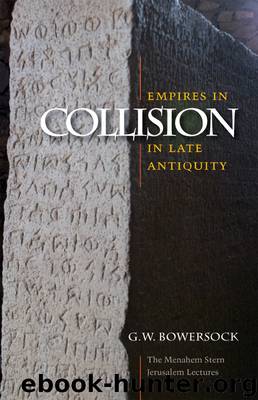Empires in Collision in Late Antiquity by Bowersock G. W.;

Author:Bowersock, G. W.;
Language: eng
Format: epub
Publisher: Brandeis University Press
3
HERACLIUS’ GIFT TO ISLAM THE DEATH OF THE PERSIAN EMPIRE
The Persian invasions of Palestine and Egypt posed a serious dilemma for the Byzantine emperor Heraclius, who had succeeded the usurper Phocas in 610. He was confronted by hostile Avars in the vicinity of Constantinople, and yet he could not ignore the Persian presence in the near-eastern territories that had formerly been his. His army suffered an ignominious defeat near Der’a in Syria in 613 that greatly impressed the local population. So Heraclius made a truce with the Avars in 623, which allowed him to carry on with a new military expedition he had launched in the previous year against the Sassanians in Anatolia and Armenia. He proceeded from a base in the Gulf of Iskenderun in the northeast corner of the Mediterranean. The Byzantine historian Theophanes Confessor states that Heraclius deliberately arranged the truce with the Avars in order to prepare for the next phase of war with Persia, and Walter Kaegi, in his study of Heraclius, declared that Theophanes was surely right. After skirmishing with Persian forces in the Taurus, Heraclius was able to outmaneuver his enemy and move from there into occupied Armenia.1
We shall see that the defeat of 613 and the subsequent campaigns did not pass unnoticed among the tribes of the Arabian peninsula. As Fred Donner has recently observed, the Prophet saw in the struggle of Heraclius against the idolatrous Zoroastrians a mirror of his own struggle against the Qurashi polytheists of Mecca.2 Now, in an unpublished paper, Michael Lecker has emphasized the coincidence of Heraclius’ new campaign in 622 precisely with the year of Muḥammad’s fateful hijra to Medina.3 He interprets this coincidence as the result of Jafnid (Ghassānid) influence exercised on behalf of their Byzantine patrons with the Khazraj of Medina. This suggestion bears important implications for the prophet’s attitude to Byzantium, to which we must later return. Heraclius persevered in Armenia, but by 626 a renewed Persian assault on Constantinople, cunningly launched by Khosroes together with his Avar allies, compelled him to forgo his eastern campaign and to return in haste to the capital.4 Fortunately, at this perilous time, he was able to thwart the Persian–Avar alliance, and then, with lightning speed, to launch an unexpected new initiative against Persia. In 628, by a stroke of astonishing audacity, he personally led his forces into Mesopotamia to gain a brilliant victory over Khosroes, whose reign, together with the empire he had acquired, crumbled before the Byzantine armies.5
Edward Luttwak has perceptively observed, in his new book on the “grand strategy” of the Byzantine Empire, that in his Mesopotamian campaign Heraclius ignored all the conventional wisdom of Byzantine warfare by taking his troops deep into enemy territory, where they might have been isolated and annihilated. This was, in his words, “a high-risk, relational maneuver on a theater-wide scale—a historical rarity in itself.”6 But in this case it paid off.7 The sudden and unexpected elimination of Khosroes sounded the death knell of the Sassanian Empire. His successor
Download
This site does not store any files on its server. We only index and link to content provided by other sites. Please contact the content providers to delete copyright contents if any and email us, we'll remove relevant links or contents immediately.
| Africa | Americas |
| Arctic & Antarctica | Asia |
| Australia & Oceania | Europe |
| Middle East | Russia |
| United States | World |
| Ancient Civilizations | Military |
| Historical Study & Educational Resources |
The Daily Stoic by Holiday Ryan & Hanselman Stephen(3111)
The Fate of Rome: Climate, Disease, and the End of an Empire (The Princeton History of the Ancient World) by Kyle Harper(2876)
People of the Earth: An Introduction to World Prehistory by Dr. Brian Fagan & Nadia Durrani(2620)
Ancient Worlds by Michael Scott(2496)
Babylon's Ark by Lawrence Anthony(2433)
Foreign Devils on the Silk Road: The Search for the Lost Treasures of Central Asia by Peter Hopkirk(2389)
The Daily Stoic by Ryan Holiday & Stephen Hanselman(2346)
India's Ancient Past by R.S. Sharma(2300)
MOSES THE EGYPTIAN by Jan Assmann(2277)
The Complete Dead Sea Scrolls in English (7th Edition) (Penguin Classics) by Geza Vermes(2139)
Lost Technologies of Ancient Egypt by Christopher Dunn(2113)
The Earth Chronicles Handbook by Zecharia Sitchin(2103)
24 Hours in Ancient Rome by Philip Matyszak(1976)
Alexander the Great by Philip Freeman(1965)
Aztec by Gary Jennings(1880)
The Nine Waves of Creation by Carl Johan Calleman(1785)
Curse Tablets and Binding Spells from the Ancient World by Gager John G.;(1769)
Before Atlantis by Frank Joseph(1741)
Earthmare: The Lost Book of Wars by Cergat(1717)
